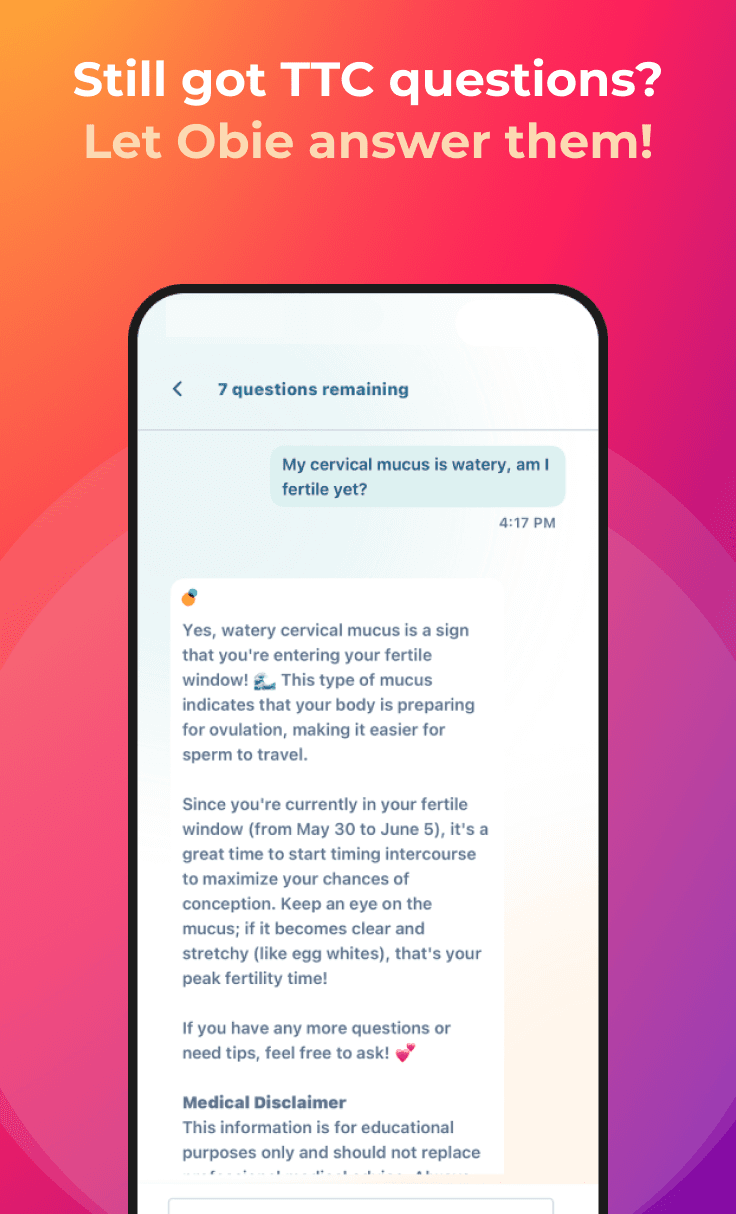FertilChart - Fertility Charting Online
Fertility Charting
Obie Editorial Team
By charting your basal body temperature (BBT) you can learn more about your fertility and keeping a BBT chart is a very exciting way to get pregnant. It makes you understand your body and often gives trying to conceive (TTC) more of a purpose.
About half of all couples will get pregnant after 5-6 months of trying and 85% will be pregnant within one year. But fertile couples who know when they are fertile and who make love frequently during their fertile days have a better chance of getting pregnant sooner.
How do you become one of these couples and increase your chances of getting pregnant earlier? You should try finding out exactly if and when you ovulate. By charting your basal body temperature (BBT) you can learn more about your fertility and keeping a BBT chart is a very exciting way to get pregnant. It makes you understand your body and often gives trying to conceive (TTC) more of a purpose.
What is BBT when you TTC?
Just what is your basal body temperature? Simply put, it's the temperature of your body at rest. For fertility charting, it's always taken in the morning before you move or get out of bed. When the ovary releases an egg, it also releases the warmth-inducing hormone progesterone. That influx of progesterone typically makes body temperatures rise by well over two-tenths of a degree Fahrenheit within one to two days after ovulation. This elevated BBT remains until the next menstrual period.
So there is a certain lower temperature pattern before ovulation (usually below 98 degrees Fahrenheit), and an elevated temperature pattern after ovulation (usually above 98 degrees Fahrenheit). This ovulation pattern is called a biphasic curve.
Biphasic means two phases. The first phase, the phase before ovulation, is known as the proliferative or follicular phase, the phase when the egg matures and develops. The second phase, the phase after ovulation or the postovulatory phase, consists of relatively elevated temperatures when compared with the first phase. That second phase is also known as the secretory or luteal or corpus luteum phase.
Your goal in charting is to find the typical biphasic pattern in the daily plotting of temperatures.
"Ah, I get it," you say. "'Bi' means two -- two phases. Lower temps before the big 'O' and higher temps after." Exactly! The actual temperatures are not important; they are different from woman to woman. What is important is to check for the pattern of elevated temps that stay up for at least three or more days.
Why chart?
Fertility or basal body temperature charting is done for several reasons:
- To see when and if you ovulate
- To calculate the cycle length
- To assess if you made love at the right time
- To diagnose a pregnancy early on
- To evaluate your cycle for fertility problems
- To see if your fertility medication was successful
- To correlate other fertility signs such as cervical mucus or cervical position with actual ovulation on a BBT chart (see Other Signs below)
- To calculate the follicular and the corpus luteum phases (a key to possible infertility issues)
More about this last point: You remember I mentioned that a biphasic curve has two phases: before and after ovulation. Charting not only helps you plot the biphasic curve, but you can measure the length of the two phases as well. If the second phase is too short (less than 12 days), this can cause problems with the implantation of fertilized eggs. Fertility charting can help reveal such an issue.
Getting started
Now you have an idea what charting is and why to do it, so let's look at how to do it:
Start keeping track of your temperature on the first day of your period (the first day you see bright red blood).
- Use a basal body thermometer (you should be able to get one at your local drugstore) that shows precise changes of one-tenth of a degree in your temperature. Some doctors suggest using a glass or mercury thermometer because they feel it's more accurate. But in most cases, a special digital thermometer is fine for taking the BBT. The digital ones have advantages: They are harder to break; some may remember the temperature for you if you don't want to chart it immediately; they beep when it's ready for use, and you don't have to shake down the thermometer after taking your temperature.
- The temperature can be taken either in your mouth or the rectum (or even in the vagina). But you must take it always the same way throughout the menstrual cycle and preferably with the same thermometer. Don't switch thermometers mid-cycle.
- Do not move, do not get out of bed, do not eat, drink, or smoke before you take your temperature.
- Take your temperature at the same time each day (within 30-60 minutes is fine).
- If you get up earlier or sleep in later, take your temperature as usual and make note of the time. We do not suggest "adjusting" a temperature just because you may have taken it earlier or later than usual.
- Sleeping for a shorter time period or drinking alcohol the night before may affect the accuracy of the temperatures. Write down the temperature after you have taken it. Do it immediately after reading it, otherwise, you might forget the temperature later on. You can record your temperature on a paper chart or by using online charting software. Paper charts are usually included within the BBT thermometer package or available at your Ob-Gyn's office.
- Calculate your coverline after you have detected ovulation.
I had you until that last part, right? The coverline is a horizontal line drawn after ovulation to help differentiate temperatures before ovulation (low) and temperatures after ovulation (high). When your waking body temperature rises more than two-tenths of a degree higher than the previous six days, and it stays that way for at least two days, your coverline can be established.
Other signs
To maximize your success, you'll want to create a fully complete chart. That's a chart that contains a full menstrual cycle of daily temps, plus:
- A notation of when your menstrual period began
- Days marked when you baby danced. (That's "making love" in TTC speak. See more fun TTC abbreviations.)
- Recorded days of cervical mucus changes
Cervical mucus
Although it may take some detective work -- and may be a little off-putting to some -- learning to detect changes in your cervical mucus is an easy and highly effective way of predicting ovulation. According to a recent study, it's a more accurate way of predicting ovulation than BBT, although it can be used in conjunction with it.
The mucus released by the cervix serves different purposes. When you're not ovulating or approaching ovulation, cervical mucus prevents sperm from getting into the uterus at a time when you couldn't become pregnant anyway. As you near ovulation, your cervix secretes an increasing amount of mucus, and when you're at your most fertile, your cervical mucus is stretchy and clear, like the consistency of egg whites. At this point, the mucus actually protects the sperm and helps it in its journey toward the egg.
For a woman with a 28-day cycle, the pattern of changes in her cervical mucus would look something like this:
- Days 1-5: Menstruation occurs.
- Days 6-9: Vagina is dry with little to no mucus.
- Days 10-12: Sticky, thick mucus appears, gradually becoming less thick and more white.
- Days 13-15: Mucus becomes thin, slippery, stretchy, and clear, similar to the consistency of egg whites. This is the most fertile stage.
- Days 16-21: Mucus becomes sticky and thick again.
- Days 22-28: Vagina becomes dry.
However, your cycle will probably differ from this pattern, perhaps significantly, which is why it's useful to mark changes on your own fertility chart.
Ideally, you should check your cervical mucus daily, possibly every time you go to the bathroom. If you rub some toilet paper or your fingers -- after washing your hands -- over the opening of your vagina, you should be able to detect cervical mucus. Examine the color and consistency between your fingers and make sure to note it down.
Why check cervical mucus? Because your basal body temperature (BBT) usually indicates ovulation only after it has happened, checking the cervix or the cervical mucus can help predict impending ovulation. The cervical mucus changes several days before ovulation by becoming more abundant and stretchy (often called egg white cervical mucus or EWCM). Within one to two days after ovulation, these typical changes disappear.
You can feel your cervix by gently inserting one or two fingers into the vagina and palpating the cervix at the end of the vagina. Prior to and after ovulation, the cervix feels firm, low, closed, and dry. Around the time of ovulation, the cervix feels soft, high, open, and wet.
As a side note, you cannot diagnose a pregnancy early on from examining the cervix, because these changes are too subtle to pick up and usually do not appear until well after you miss your period.
Using an ovulation predictor kit (OPK) can also help you predict when you are about to ovulate. The OPK is a test that checks your urine for the presence of the luteinizing hormone (LH). Normally, LH is in a steady state, at a low level (negative test). But when it rises very quickly (LH surge) it stimulates the developing egg (follicle) and ovulation (release of the egg) follows shortly thereafter. Ovulation usually happens within 12-36 hours after the OPK first turns positive.
Read More









